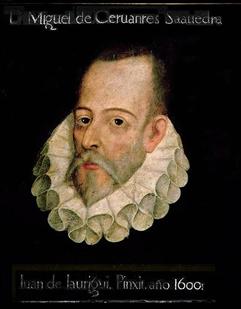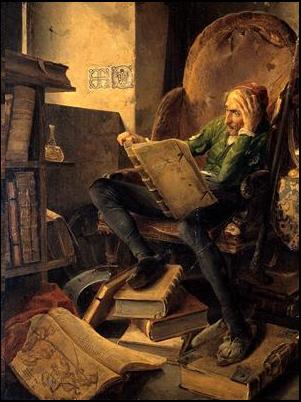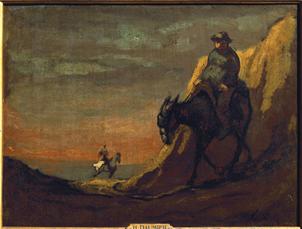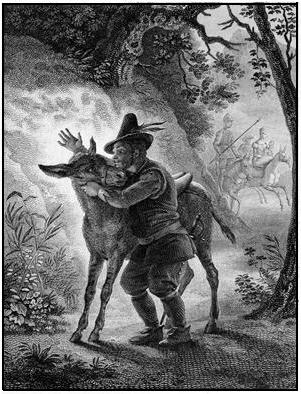
|
Volume 29, Number 5
|
BY ILAN STAVANS
Don Quixote de la Mancha is a book for all seasons: esteemed, even venerated by millions, but, maddening in its length and contradictions, a constant target of attacks. The opinions it has generated throughout history are plentiful. Lord Byron believed Cervantes had “smiled Spain’s chivalry away,” while art critic John Ruskin perceived the novel as “a deadly work.” The Czech writer Milan Kundera maintains that “Cervantes is the founder of the Modern Era” and that “the novelist need answer to no one but Cervantes.” The German cultural critic Walter Benjamin infers that Don Quixote, “the man with a single conviction . . . , teaches us that in this, the best or worst of all conceivable worlds (except that this world is inconceivable), the conviction that stories of chivalry are true can make a whipped fool happy, if it is his only conviction.”
Likewise, Lionel Trilling convincingly asserted that “it can be said that all prose fiction is a variation on the theme of Don Quixote.” Vladimir Nabokov, with typical fastidiousness, squabbled that seldom has an author been as cruel to his character, although he also recommended that we “do our best to avoid the fatal error of looking for so-called ‘real life’ in novels.” Nabokov added: “Let us not try and reconcile the fiction of facts with the facts of fiction. Don Quixote is a fairy tale, so is Bleak House, so is Dead Souls. Madame Bovary and Anna Karenin are supreme fairy tales. But without these fairy tales the world would not be real.”
And if the story of the responses to Don Quixote isn’t sufficiently fecund, its adventure in translation is proof of its vitality, but also of the acrimony it has left in its wake. Of course, translating a classic, any classic, ends up generating enough rage for at least a fistfight, if not enough to mobilize an army. It is the equivalent of dressing up a traditional bride with a new wedding dress. Will it be appropriate? Does it make her look svelte? Is it fitting with her personality? Judging by the frequency with which translators revitalize a centuries-old narrative and publishers reintroduce it through savvy marketing strategies to contemporary readers, the endeavor is rather attractive.
Take the Bible as an example. About a dozen full-fledged renditions have appeared since World War II, by many talented translators, including scholars Everett Fox and Robert Alter. The King James Version released almost four hundred years ago, is still the runaway best seller. The fact that it is still marketed as the “authorized” version (by none other than the Church of England, an institution with arguably little standing outside the United Kingdom today) doesn’t appear to deter anyone. Without putting as much as a dent in the sales that the King James cadre of translators continues to generate, each of the new versions has printings of thousands of copies, not bad at all, especially at a time when the act of reading is going through a disheartening crisis.

Portrait of Miguel de Cervantes y Saavedra (1547–1615), by Juan de Jauregui y Aguilar.
|
|
| —Real Academia de la Historia, Madrid, Spain. The Bridgeman Art Library |
While Russian readers have only one Tolstoy, we in English have a plethora. Which of the two languages is richer in its Tolstoyan tradition? On one hand, the original words are set forever. On the other, all of the translations are guesses. But, in the modern world, translation is a necessary, unavoidable task, and, when in the dark, most people are fine with a guess.
After all, we live in the age of relativism. There are no absolute truths. And while an original text has the advantage of being the source, the endless copies it generates are forms of interpretation, which is, in the end, what literature is about. No one would dare to tinker with the fixed Latin of the Aeneid. But compare the first sentences of Robert Fagles’s and Sarah Ruden’s renditions and you’ll realize the extent to which translators are creators. If anyone dared to embark on a retranslation of Virgil’s epic in dactylic hexameter back from one of its English versions to the original Latin, I suspect the result would be utterly unrecognizable to Virgilian connoisseurs. And can a translation be better than the original? Well, when the original language isn’t available to the reader, the translation is surely better. Actually, not really better, but the only way to access a classic.
I am often at the receiving end of a litany from sophisticated readers who complain that the book industry in New York has little interest in translation of classic and commercial titles. Publishers say that translations of contemporary works into English are few and far between because English-language readers are a proud pod that doesn’t like to read in translation, which explains why so few new translations are done every year. People, in turn, say that the limited sales of books in translation are a result of our provincial worldview (at its center, the empire is always parochial) and that if publishers made a legitimate effort to release more new translations, that provinciality would decrease. It’s the chicken-or-egg conundrum. This, from a language with a long-standing obsession with translation. Think of the Homer translations by Alexander Pope, Edward FitzGerald, and Matthew Arnold, to name but a triptych of controversial practitioners.
Still, when compared with other European-based tongues (French, Dutch, Spanish, and Portuguese), the English-language publishing industry is enviably vibrant. Shakespeare’s language has been a global vehicle of communication for half a millennium. What gets published in English today sets standards worldwide, even of the classics. There are several full-fledged renditions of Madame Bovary into Spanish, but, by my own estimation, not nearly as many as those available in English—to use conservative numbers, half a dozen, by translators like Stephen Heath, Mildred Marmur, Francis Steegmuler, and Eleanor Marx Aveling. Reading them in comparative fashion, as I’ve done recently, is both a treat and a threat, an endless form of joy as well as a source of puzzlement. Is it really Flaubert who is behind them all?
I can’t think of a more rancorous translation surfeit, a fiesta of larger possibilities, than the multiplications in English of Don Quixote, by far my favorite book. It is an inexhaustible study of human frailties, an open novel about friendship, love, liberty and censorship, about pursuing one’s own dreams, about reading and mental illness, about class struggle, about the power of the imagination and the absurdities of old age, about choosing between a soldier’s and a writer’s life. It is, in my estimation, a secular Bible: everything about the so-called enlightened society is contained in it. I’ve reread the volume countless times and have reached the conclusion that the universe was created with Don Quixote as one of its fixtures. Without it, life would feel incomplete.

The painter Adolf Schroedter’s interpretation of Don Quixote reading Amadis of Gaul, a novel of chivalry.
|
| —Bildarchiv Preussischer Kulturbesitz/Art Resource, NY |
I’ve counted eighteen different complete English versions, although some might exist under the radar. No other classic has been revamped as often into Shakespeare’s tongue, and, yes, as atrociously. What a gang of divergent souls Cervantes’ translators are: postmen, surgeons, linguists, painters, playwrights, poets, journalists, teachers, scholars, editors, collectors, naughty craftsmen, and downright plagiarists. There are rumors that at least one didn’t even know Spanish.
James Fitzmaurice-Kelly, once a professor of Spanish language and literature at the University of Liverpool and a prolific editor, translator, and biographer of Cervantes, persuasively showed that the British were the first in a “foreign country to mention Don Quixote, the first to translate the book [followed by French, German, and Italian], the first . . . in Europe to present it decently garbed in its native tongue, the first to provide a biography of [its author], the first to publish a commentary on [the novel], and the first to issue a critical edition of the text.”
The first of two parts of Don Quixote, published in Madrid in 1605, appeared in Shakespeare’s tongue in 1612, translated as The delightfull history of the wittie knight, Don Quiskote by Thomas Shelton. (The complete title of the novel keeps on changing from one translation to another.) As a critic in 1613 put it, the “venerableness” of his style, “the rich and easy eloquence with which it steals on the soul, are such as no modern language can equal.” It has been suggested that Shelton might have known Cervantes personally, since he traveled to Spain, but no proof has emerged. The second part, which Cervantes released in 1615, the year before his death, was translated by Shelton. In his dedication, Shelton, a personal-letter carrier from England to Dublin, explained that he translated the novel for a friend who didn’t know Spanish in a period of forty days, no doubt an astonishing time, even by our fast-speed, impatient standards. For the first part, he didn’t use the original edition but a 1607 version of Don Quixote issued in Brussels. For the second part, Shelton used the Brussels version of 1616, releasing his translation in 1620. At the same time, he offered a revised version of his rendition of the first half. The public and critical reactions were quite positive, although a few successive translators, such as John Ormsby, himself the author of the respectable 1885 translation, accused Shelton of having an incomplete knowledge of Spanish.
Fitzmaurice-Kelly is also right in the assiduity of quotations: unquestionably, references to the knight’s odyssey have been ubiquitous in English from the eighteenth century on, showing up in the works of Ben Jonson, Henry Fielding, Samuel Johnson, Joseph Addison and Richard Steele, Laurence Sterne, Washington Irving, Cotton Mather, Thomas Morton, Herman Melville, Mark Twain, William Faulkner, Ernest Hemingway, Graham Greene, V. S. Naipaul, and Salman Rushdie. And then there is the inevitable question about the Bard: did Shakespeare read the first part of the novel? The answer is the subject of some polemics, for while Shakespeare knew a little Spanish, Shelton’s translation was released a few years before Shakespeare died, which was within days of Cervantes’ own demise.
All this is to say that, while it might seem preposterous to suggest that the fanciful adventures of Don Quixote are far richer in English than in Spanish, the proof is in the pudding. By rich, I mean abundant and comprehensive. There are more Quixote possibilities in English. Some of Shelton’s successors accused him of inaccuracy, especially when it came to rendering Sancho’s proclivity for using proverbs to convey his thoughts. Sancho comes across as a parrot-like proverb machine, which makes me think of a statement Borges once made to the effect that focusing too much on Sancho’s proverbs is to misunderstand the novel’s intention: the point is not that Cervantes loved proverbs but that he wanted Sancho to be plainspoken.
In 1687, John Phillips, one of John Milton’s nephews and the author of an attack on Oliver Cromwell and Puritanism, translated Cervantes’ novel. His critics, and they are plentiful, contend his work is barely an approximation. Phillips didn’t use the Spanish original. He based it, as was his custom in general, on a French translation by Filleau de Saint-Martin. The effect is like drinking fresh water from a plastic bottle. Unsurprisingly, Samuel Putnam, himself a translator of the novel, who in my estimation has produced one of the best English-language renditions, published in 1949, called it the worst English translation ever made of a famous novel.
Among the most famous renditions is that of Peter Anthony (aka Pierre Antoine) Motteux, published in 1700. After the revocation of the Edict of Nantes sent French Protestants abroad, Motteux, a native of Rouen, moved to England, where he became editor of the Gentleman’s Journal. He completed the Scottish translator Sir Thomas Urquhart’s rendition of Book III of Rabelais’s Gargantua and Pantagruel, published in 1693. He also translated other works, such as The Present State of the Empire of Morocco, by François Pidou de Saint-Olon.

Don Quixote and Sancho Panza, 1864–1865, by Honoré Daumier.
|
|
| —Erich Lessing, Art Resource, NY |
Charles Jervas, an Irish painter and collector whose portrait of Swift is in London’s National Portrait Gallery, enjoyed calling attention to Motteux’s errors. Jervas, who is now known as Jarvis because of a printer’s typographical error, took on Motteux in a comparative analysis of previous translations. His posthumous translation, released in 1742 with what appears to be the first introduction about Cervantes and his work, is, in my opinion, more trustworthy, although Alexander Pope, a onetime friend, purportedly remarked, perfidiously, that Jarvis “translated Don Quixote without understanding Spanish.”
Tobias Smollett, the author of the novels Humphrey Clinker and Roderick Random, translated the novel in 1755. Carlos Fuentes generously called the version “the homage of a novelist to a novelist.” My opinion is far more radical: Smollett’s translation is an abomination. Writing in the third person in a translator’s note, he claims his aim
was to maintain that ludicrous solemnity and self-importance by which the inimitable Cervantes has distinguished the character of Don Quixote, without raising him to the insipid rank of a dry philosopher, or debasing him to the melancholy circumstances and unentertaining caprice of an ordinary madman; and to preserve the native humor of Sancho Panza, from degenerating into mere proverbial phlegm, or affected buffoonry. He has endeavored to retain the spirit and ideas, without servilely adhering to the literal expression, of the original; from which, however, he has not so far deviated, as to destroy the formality of idiom, so peculiar to the Spaniards, and so essential to the character of the work.
Smollett, as might be expected, was accused of taking too many liberties. A revised version appeared in 1761.
The parade of renditioners includes uneven efforts by John Stevens (1700), George Kelley (1769), T. T. Shore (1864), Henry Edward Watts (1888), and Robinson Smith (1910). Each has had the work of his predecessors at his disposal, both for inspiration and to pillage. At times a previous translation, perhaps in the public domain, was slightly edited and then reprinted under a new translator’s name.
Released in 1961, the version by J. M. Cohen, an editor at Penguin Books in England and an authority on Spanish and Latin American letters, strikes me as lacking ambiguity. And what is ambiguity if not richness? In fact, Cohen replaces ambiguity with howlers, at one point describing someone as “a sow-gelder.” Burton Raffel, a professor at the University of Southwestern Louisiana and also a prolific translator (his bibliography includes translations of Beowulf and works by Rabelais and Balzac) makes Cervantes’ hero more industrious, less starkly opposed to the circumstances in which he lives. A dramatic change occurs between Motteux and Raffel. In the Renaissance, Don Quixote is laughed at as a loony. The Romantic Movement turns him into a champion of individualism. Finally, postindustrial capitalism strikes a balance by making the individual and society equally potent adversaries.
 Sancho retrouvant son ane, an engraving by Horace Vernet, appeared in Le Don Quichotte, published in Paris in 1822.
|
|
| —1954.0672.015, The Rosenbach Museum & Library, Philadelphia |
In the scene at the inn with Maritornes and the muleteer, and in the chapter following, Motteux, Jervas, and Cohen—to take only three—are superior in vigor to Mr. Putnam, whose colloquial phrases have a citified smoothness from easy over-use. To give an example: Don Quixote is about to reveal that the daughter of the supposed Castilian had come to him in the night, but stops to make Sancho swear that he will tell no one about this until after the Knight is dead, for he will not allow anyone’s honour to be damaged. Sancho replies, without tact, that he swears, but hopes that he will be free to reveal the secret tomorrow, on the grounds that: “It’s just that I’m opposed to keeping things too long—I don’t like them to spoil on my hands.”
Both Motteux and Cohen stick closer to the more vigorous original image. The Spanish word is “go moldy”
or even “rot,” and not “spoil.” Literally “go moldy on me.” In [an] earlier chapter one
can catch Motteux adding direct, eighteenth-century animal coarseness when Cervantes is not coarse at all;
in fact, Don Quixote is unique in picaresque literature in its virtual freedom from obscenity, except in
some of the oaths. When Maritornes rushes to Sancho’s bed to hide there from her angry master, Motteux writes:
“The wench . . . fled for shelter to Sancho’s sty, where he lay snoring to some tune; there she pigged in and lay
snug as an egg.”
This is picturesque, but it has arisen from the mistranslation of two words in the text. Possibly it is an improvement on Cervantes who wrote merely that “she went to Sancho’s bed and curled up in a ball.” Mr. Putnam’s pedantry spoils his accuracy here for, instead of “ball,” he writes, “ball of yarn.” The objection to Motteux is that in making Cervantes picturesque and giving him Saxon robustness, he endangers the elegance and the finely drawn-out subtleties of the original. Motteux was half-way to Smollet [sic], which is long way from Cervantes.
By the end of the twentieth century and the beginning of the twenty-first, the quality standards of translation were notably higher. The development of scholarship on literary matters, and the rise of translation as a legitimate, if poorly remunerated profession, raised the standards of quality. The work of John Rutherford (2000), Edith Grossman (2003), and Tom Lathrop (2005) is proof of it. Given the assortment of interpretations, it isn’t advisable to suggest that a single English translation of Don Quixote is the best. I prefer to compare them—that is, to keep them all at my side. I believe the true spirit of Cervantes’ novel is to be found not by subtraction but by addition. Still, in the last few years I’ve fallen in love with Grossman’s version (she is the only woman in the bunch), which I reviewed for the Los Angeles Times when it was first published.
Grossman’s mission is inspiring: to leave aside the idea that Cervantes is a relic and, instead, to make him our contemporary. “[Cervantes’] writing is a marvel,” she writes in a translator’s note. “It gives off sparks and flows like honey. Cervantes’ style is so artful it seems absolutely natural and inevitable; his irony is sweet-natured, his sensibility sophisticated, compassionate, and humorous. If my translation works at all, the reader should keep turning the pages, smiling a good deal, periodically bursting into laughter, and impatiently waiting for the next synonym (Cervantes delighted in accumulating synonyms, especially descriptive ones, within the same phrase), the next mind-bending coincidence, the next variation on the structure of Don Quixote’s adventures, the next incomparable conversations between the knight and the squire.” I disagree with Grossman that Cervantes is such an accomplished stylist. In effect, he’s careless and repetitive (and would have benefited from a tightening editor). Among other things, the name of Sancho’s wife keeps on changing: Juana Panza, Mari Gutierrez, Juana Gutierrez, Teresa Cascajo, and Teresa Panza. And Sancho’s donkey (el rucio) disappears at one point without a trace only to reappear later on without explanation. Cervantes himself makes fun of these inconsistencies (one of the most astonishing aspects of Don Quixote, in my eyes, is the way in which it incorporates literary criticism—softly, engagingly—into the story), but that doesn't altogether streamline the bumps in the narrative.
Needless to say, the word masterpiece isn’t a synonym of perfect. There are numerous flips, malapropisms, detours, and infelicities in them. What makes the translations superior is the symmetry between form and content. More than anything else, what makes them an endless source of curiosity is the way they connect with readers across time. Grossman makes Cervantes look good. What else can an author wish for from a translator?
It is logical, at this point, to embark on an exercise of comparing available translations. Herein a quotation in the original followed by four translations, listed chronologically, of a handful of lines in part 1, chapter 38, in which Don Quixote discusses the pen and the sword, or the difference between literary and military affairs:
Cervantes:
Estoy por decir que en el alma me pesa de haber tomado este ejercicio de caballero andante en edad tan detestable como es esta
en que ahora vivimos; porque a mí ningún peligro me pone miedo, todavía me pone recelo pensar si la pólvora y el estaño me
han de quitar la ocasión de hacerme famoso y conocido por el valor de mi brazo y filos de mi espada, por todo lo descubierto de
la tierra. Pero haga el cielo lo que fuese servido.
Motteux:
I could almost say I am sorry at my Heart for having taken upon me this profession of a Knight-Errant, in so detestable an
Age; for tho’ no Danger daunts me, yet it affects me to think, whether Powder or Lead may not deprive me of the Opportunity
of Becoming Famous, and making myself known throughout the World by the Strength of my Arm and Dint of my Sword. But let
Heaven order Matters as it Pleases.
Jervas:
I could almost say, I repent of having undertaken this profession of knight-errantry, in so detestable an
age as this, in which we live; for though no danger can daunt me, still it gives me some concern, to think
that powder and lead may chance to deprive me of the opportunity of becoming famous and renowned, by the valor of
my arm and edge of my sword, over the face of the whole earth. But Heaven’s will be done.
Cohen:
It grieves me to the heart to have adopted this profession of knight errantry in such a detestable age as we now live in.
For although no danger frightens me, still it causes me misgivings to think that powder and lead may deprive me of the chance
of winning fame and renown by the strength of my arm and the edge of my sword, over all the known earth. But let Heaven
do what it will.
Grossman:
When I consider this, I am prepared to say that it grieves my very soul that I have taken up the profession
of knight errant in an age as despicable as the one we live in now, for although no danger can cause me to fear,
it still fills me with misgivings to think that powder and tin may deprive me of the opportunity to become famous
and renowned throughout the known world for the valor of my arm and the sharp edge of my sword. But God’s will be done,
for I shall be more highly esteemed, if I succeed in my purpose, for having confronted greater dangers and any faced
by the knights errant of old.
Not only does each translator insert another degree of subjectivity, they also improvise within the parameters of Cervantes’ prose. It pleases me to think that these renditioners, as conduits of the sensibility of their respective ages, have made Don Quixote fit their respective sensibilities. Whereas Motteux and Jervas are British Romantics, Cohen is down to earth, and Grossman makes him a deliciously postmodern American hodgepodge.
A classic, Mark Twain once argued, is “a book which people praise and don’t read.” Except for its translators, of course, who not only read but revise it imaginatively, at times dreaming of supplanting the author himself.
 See
See